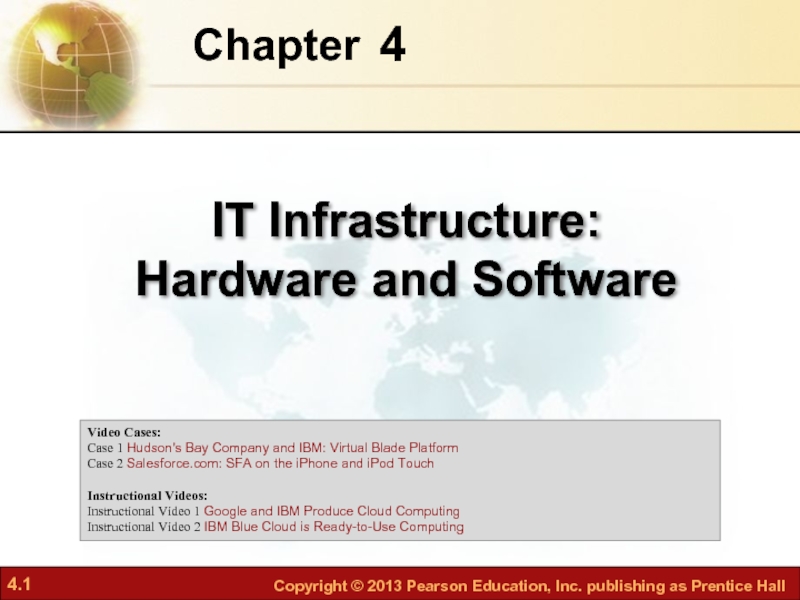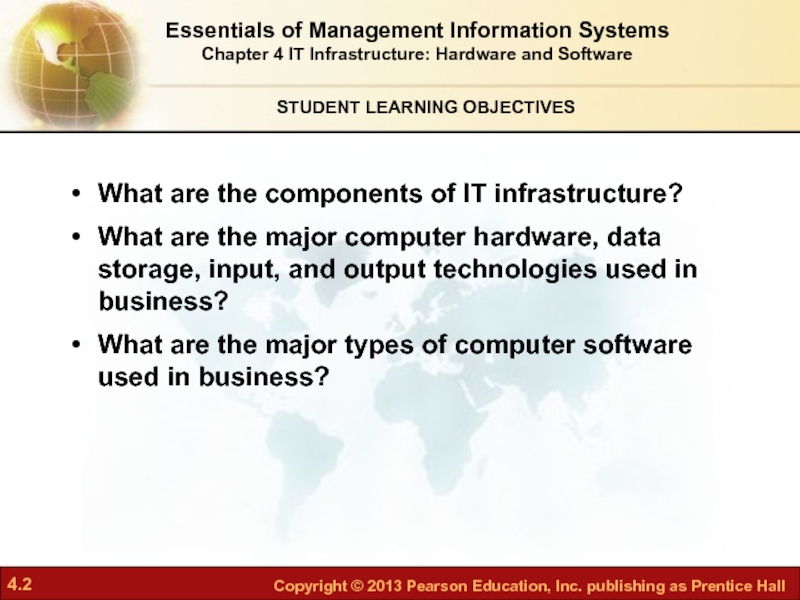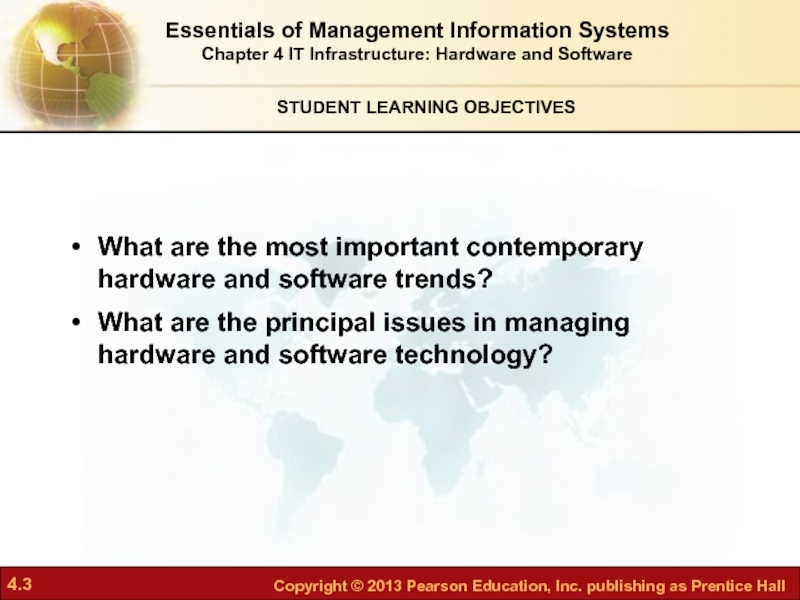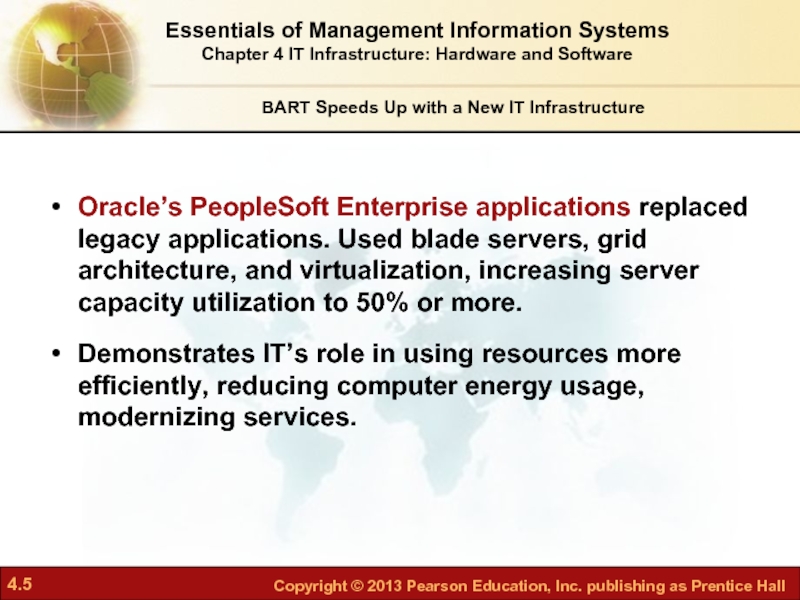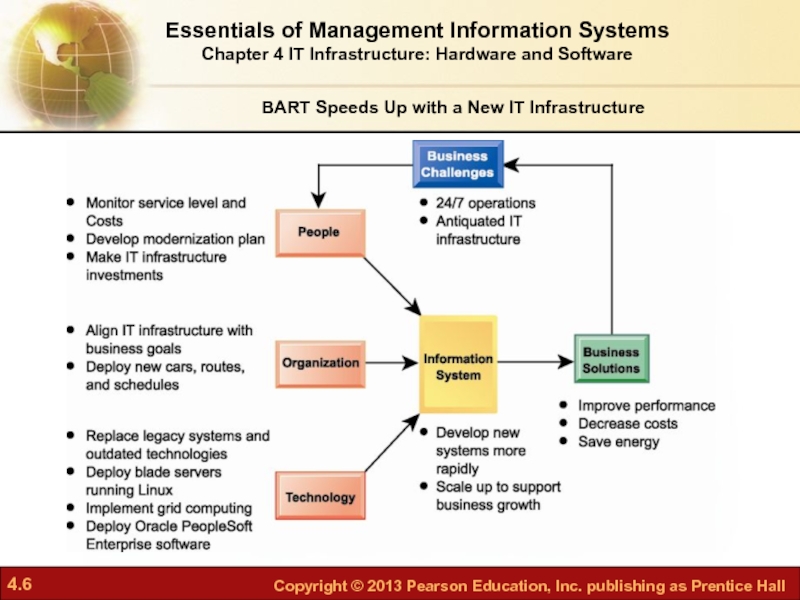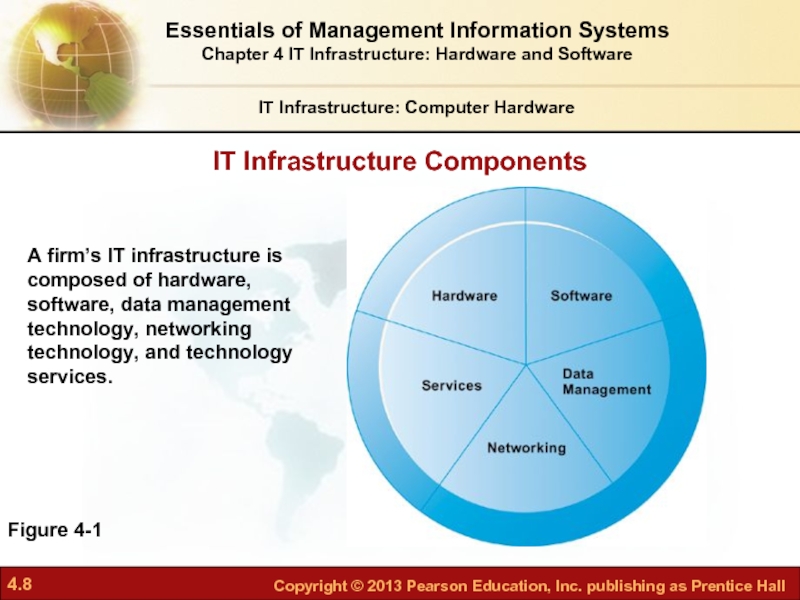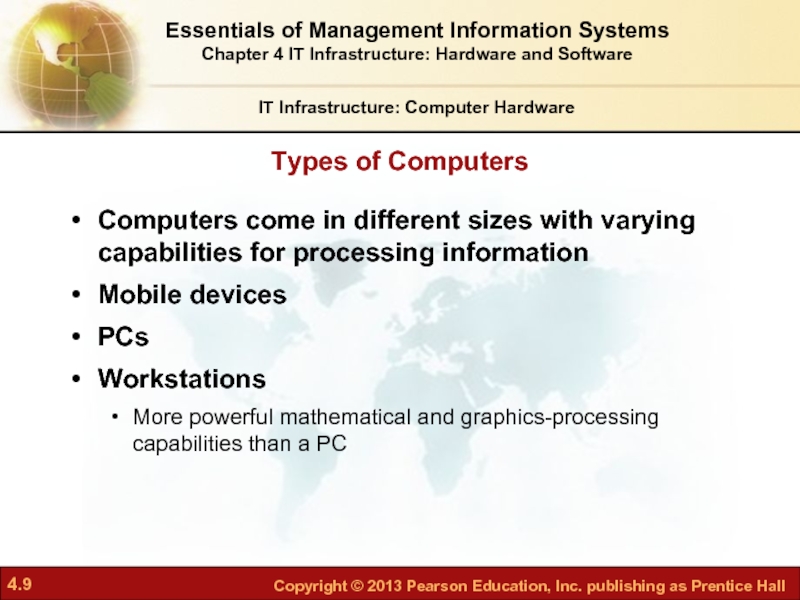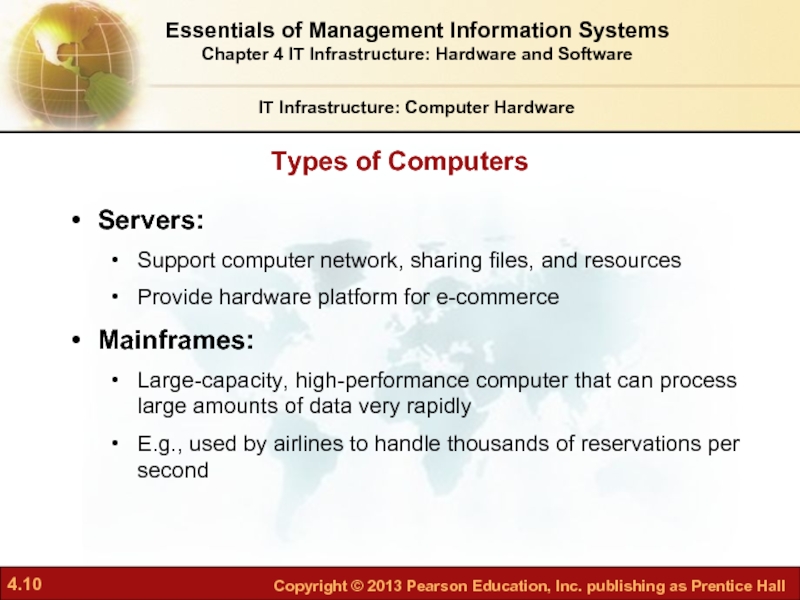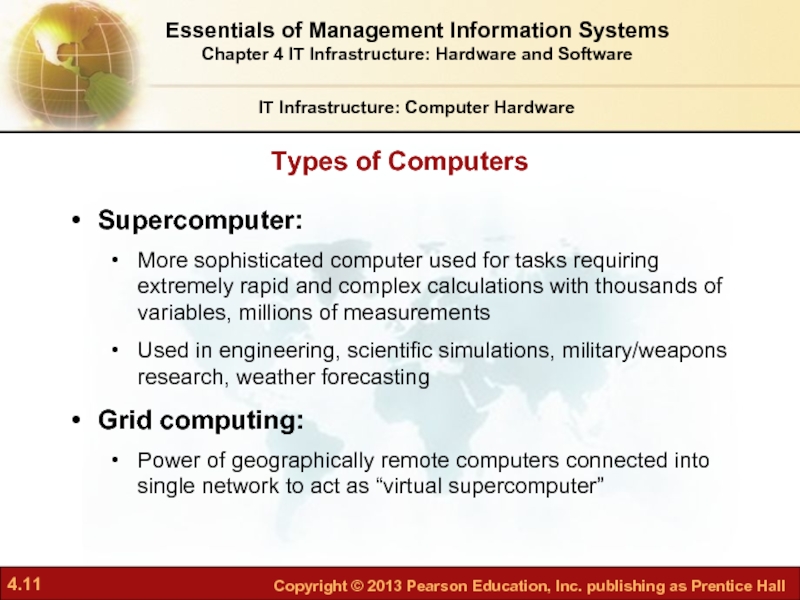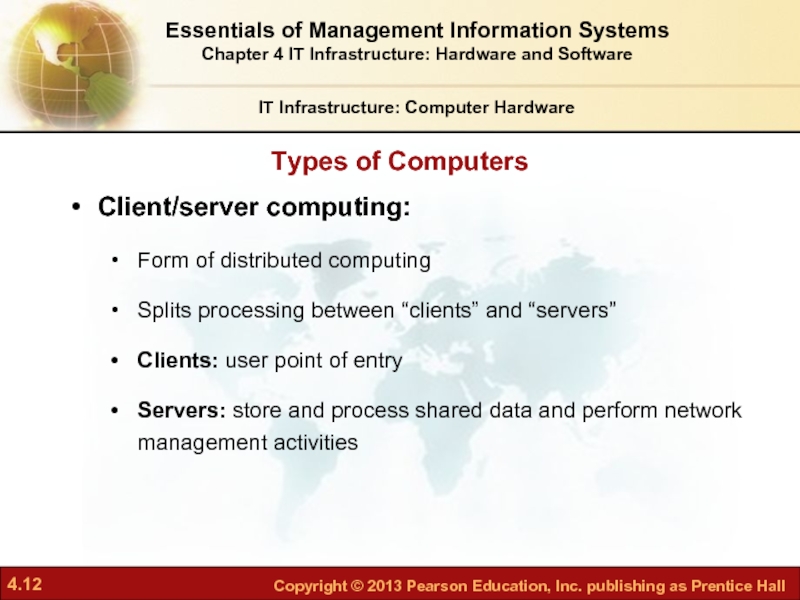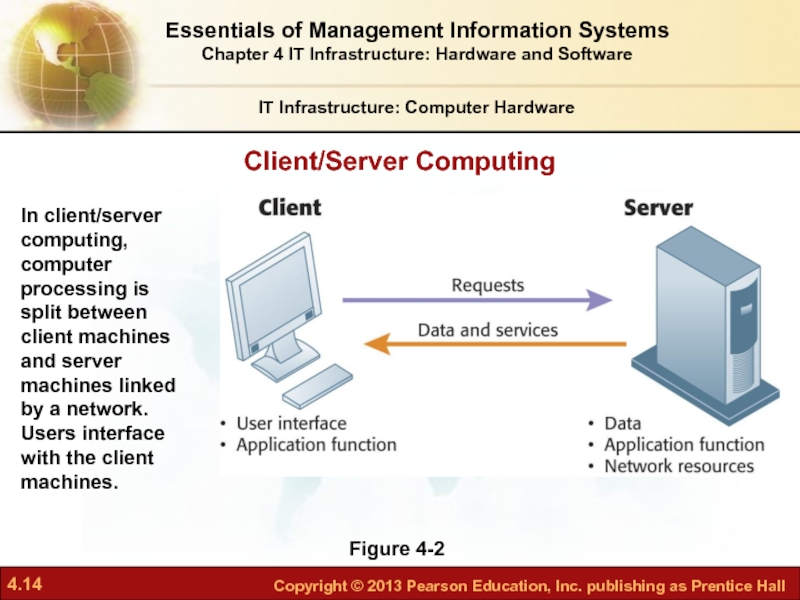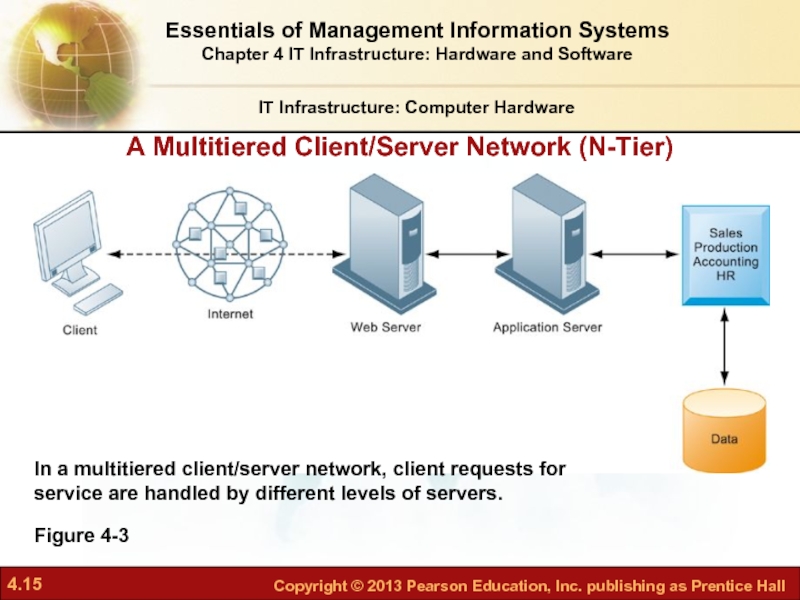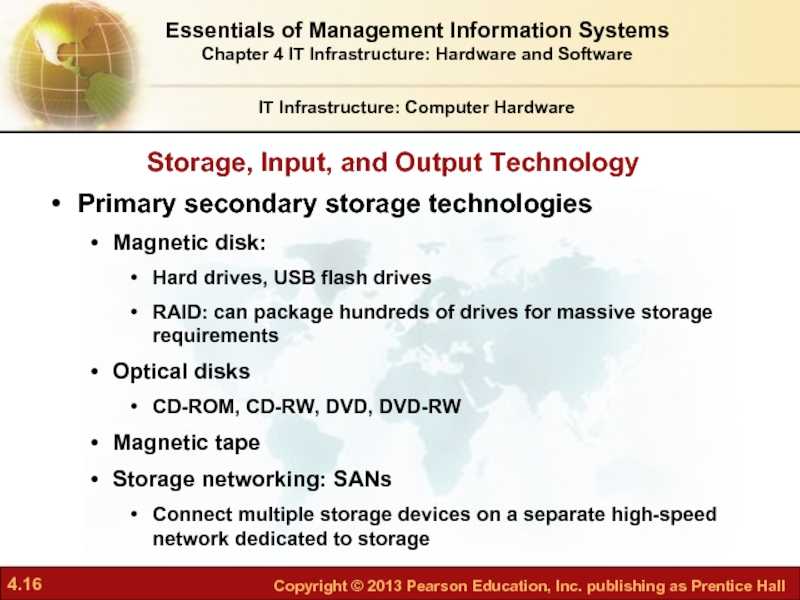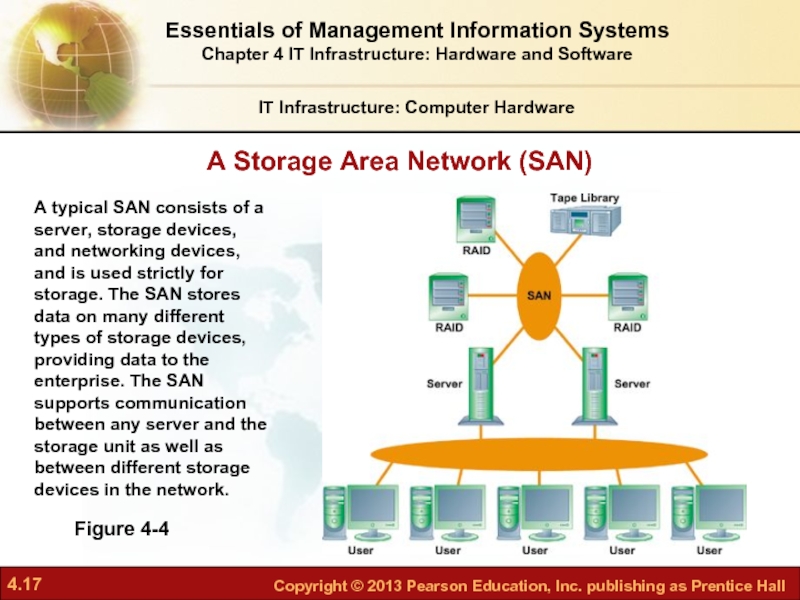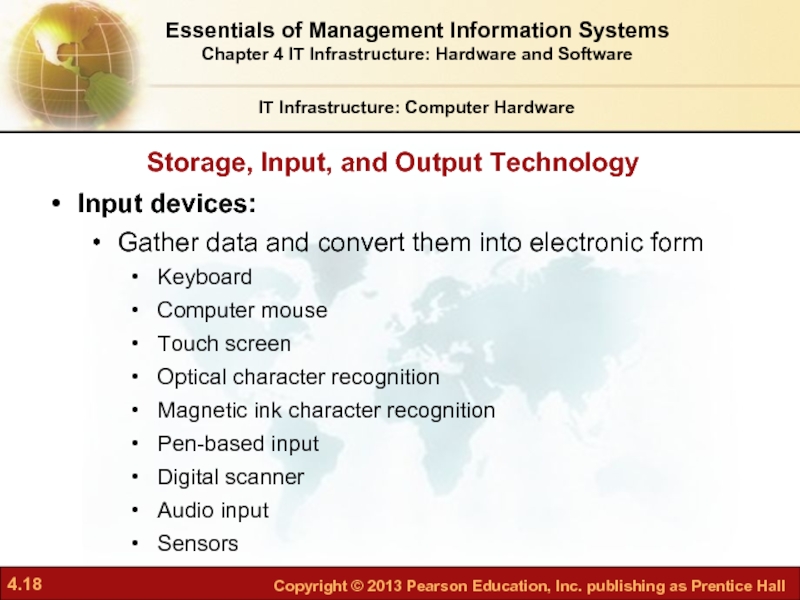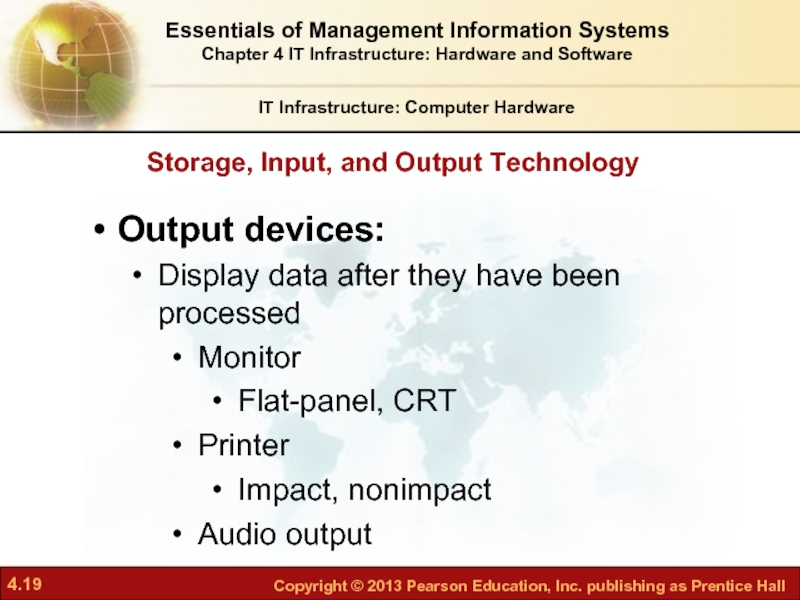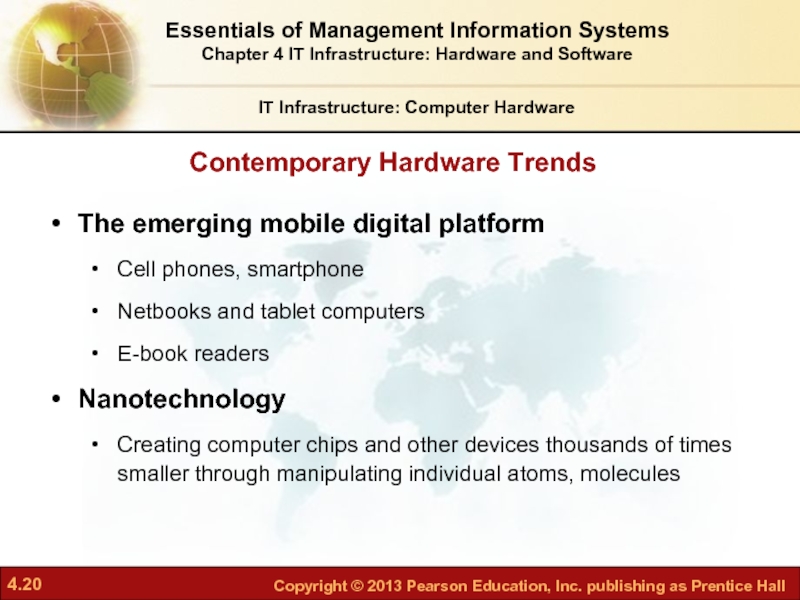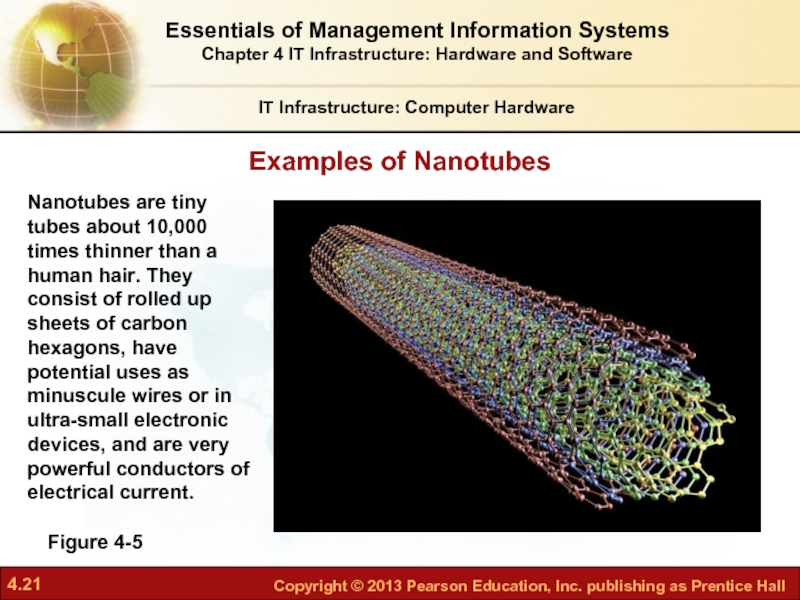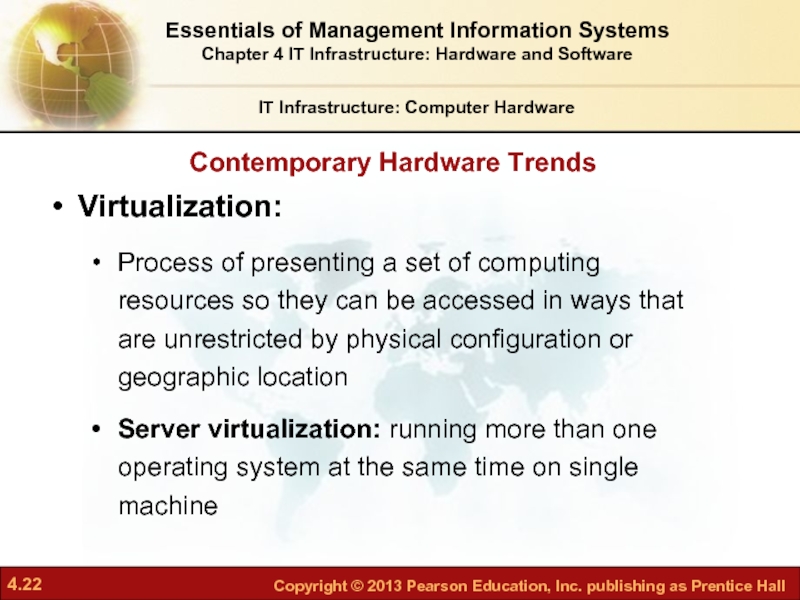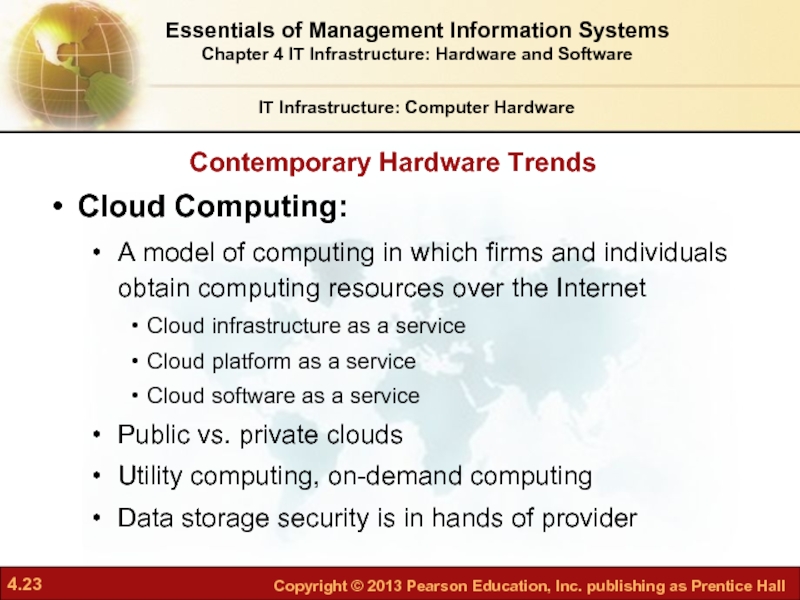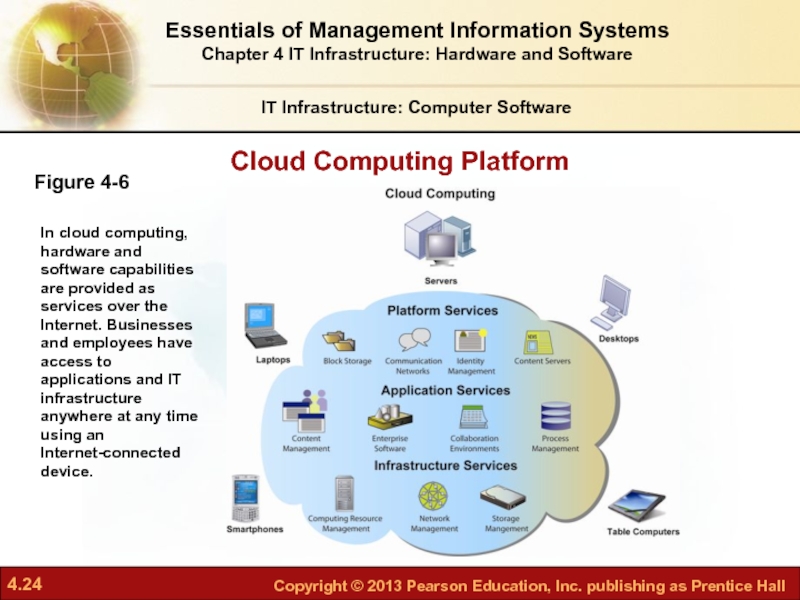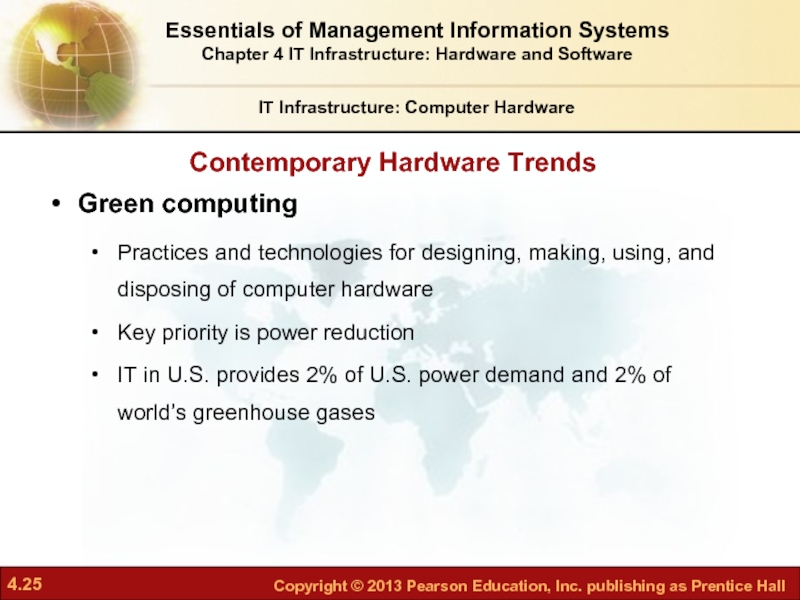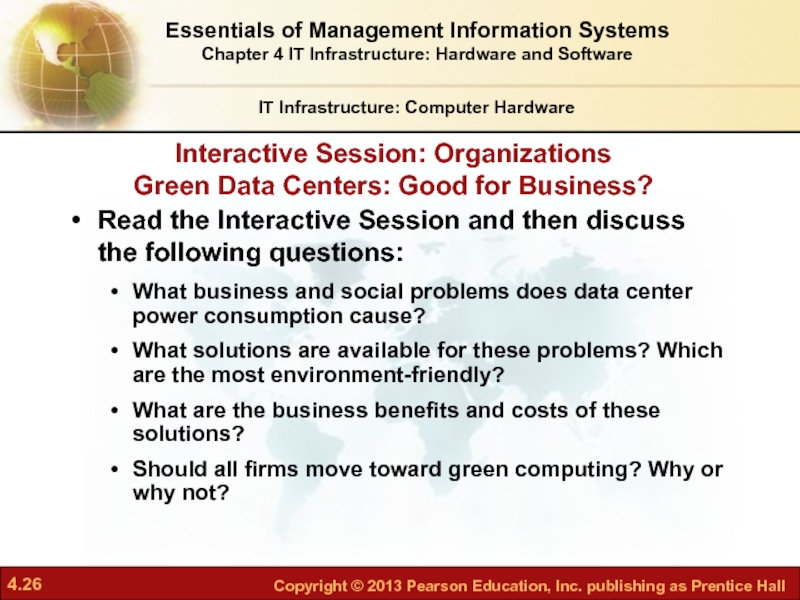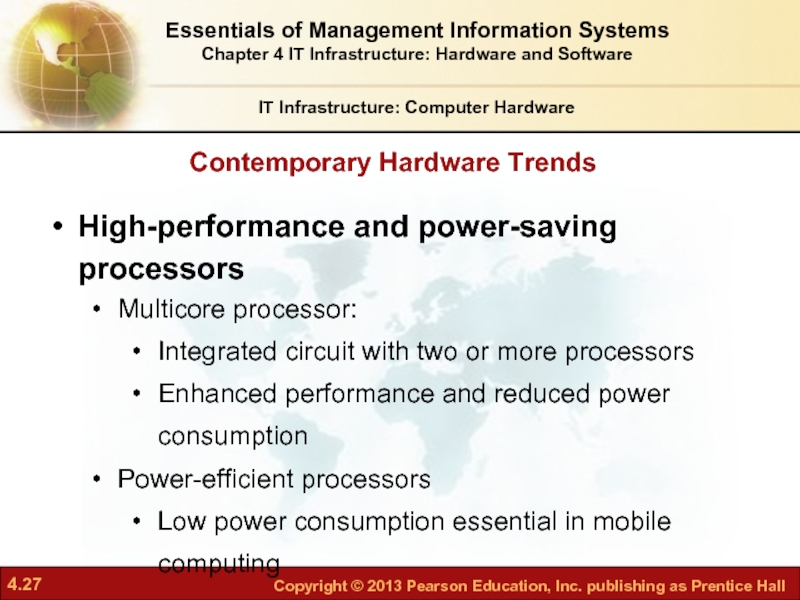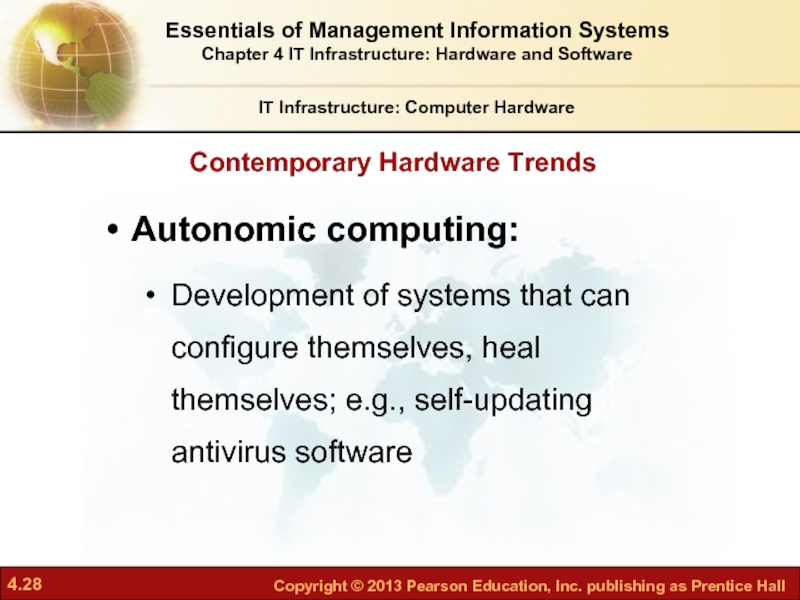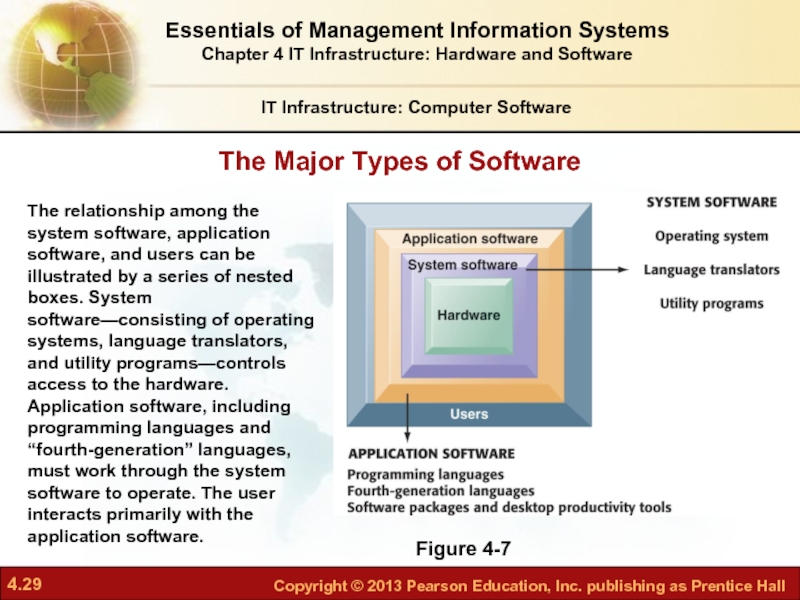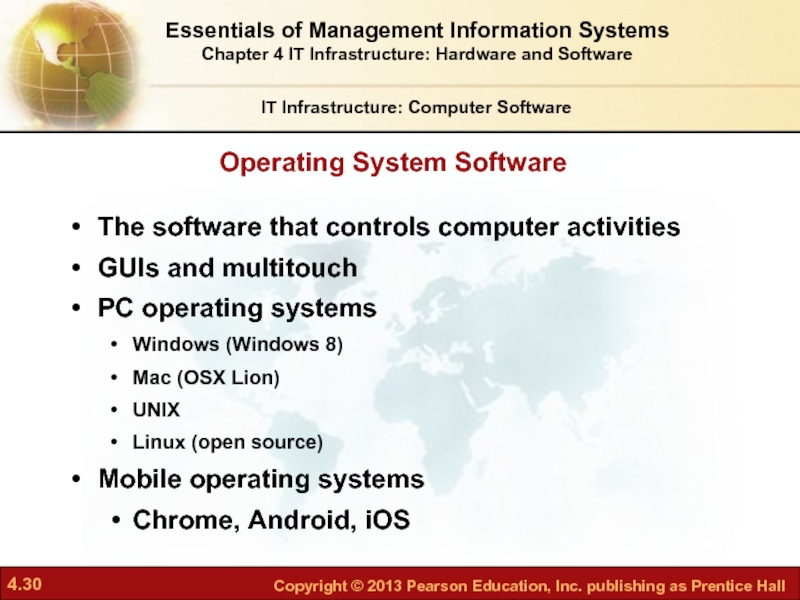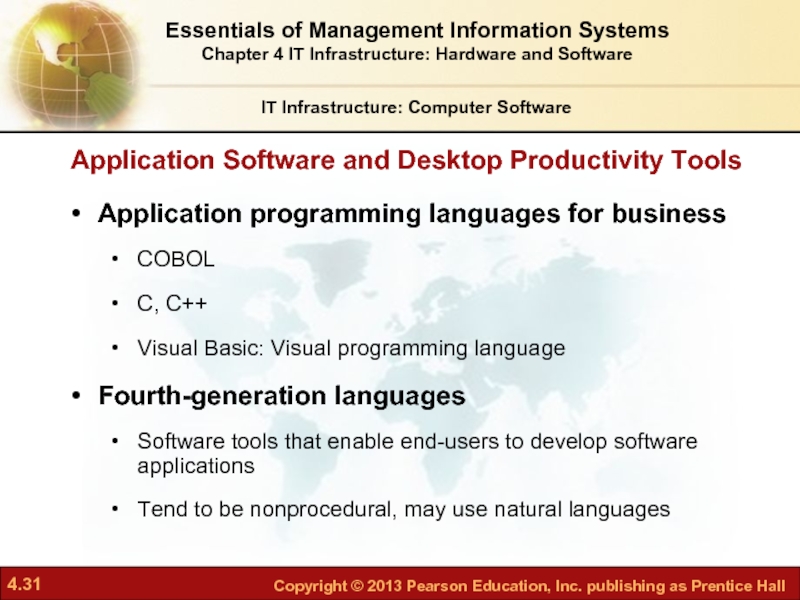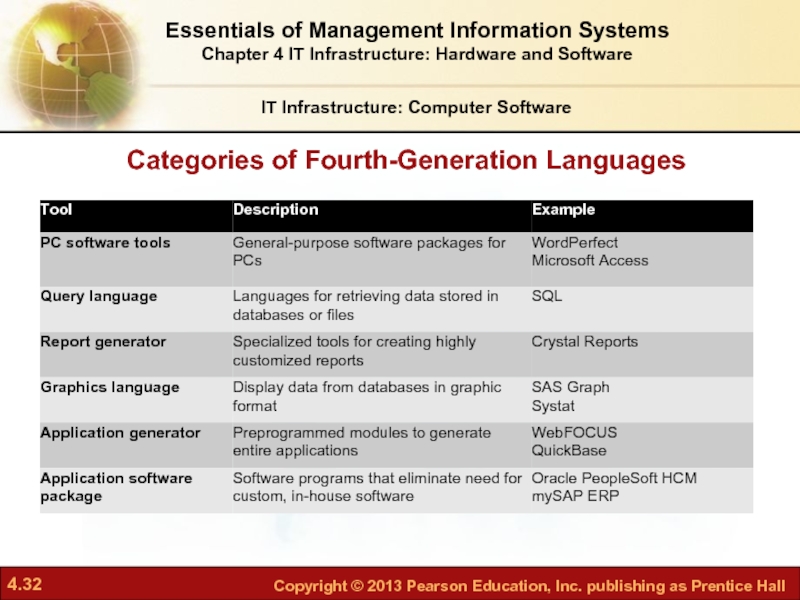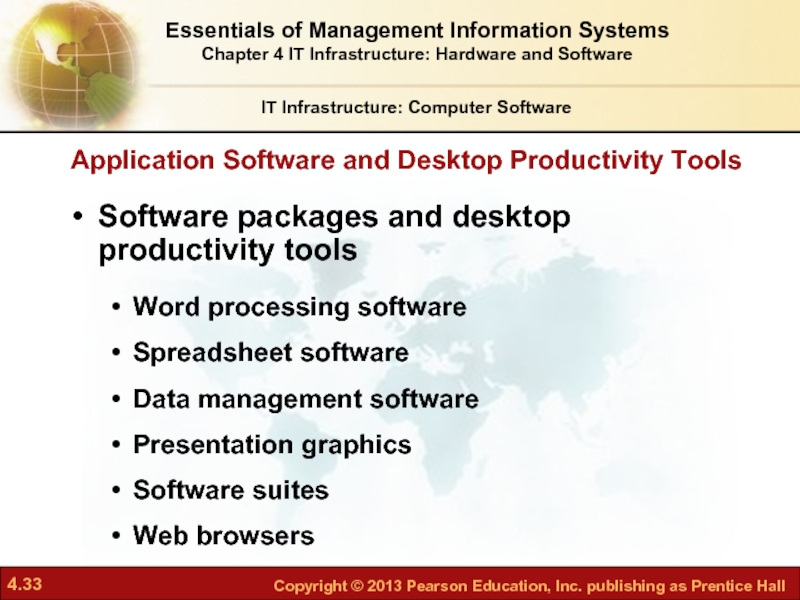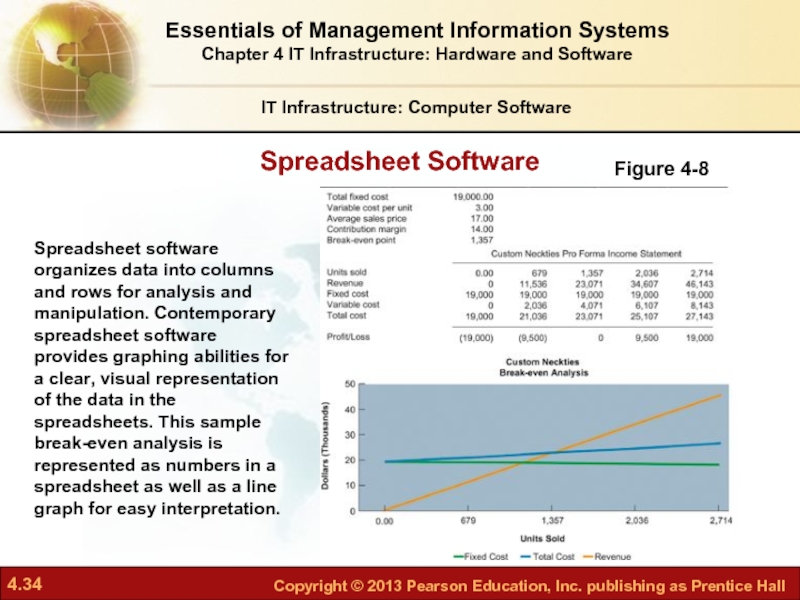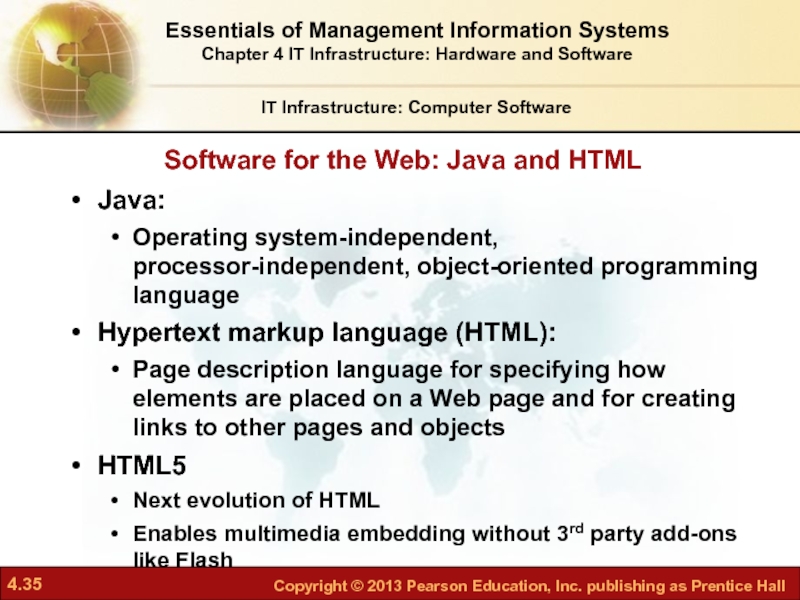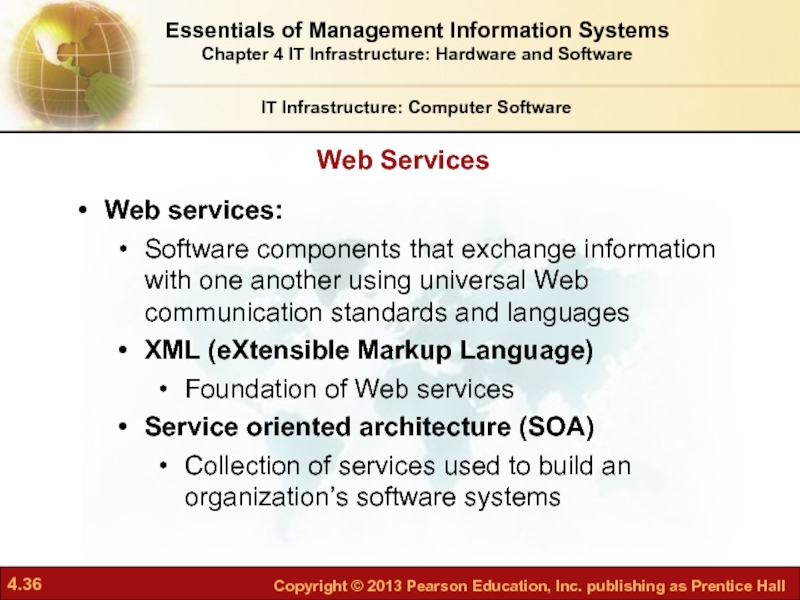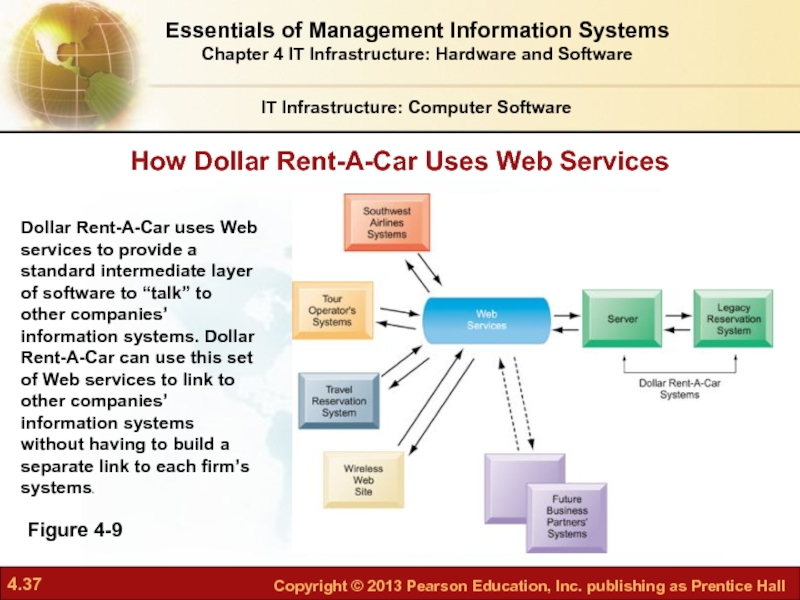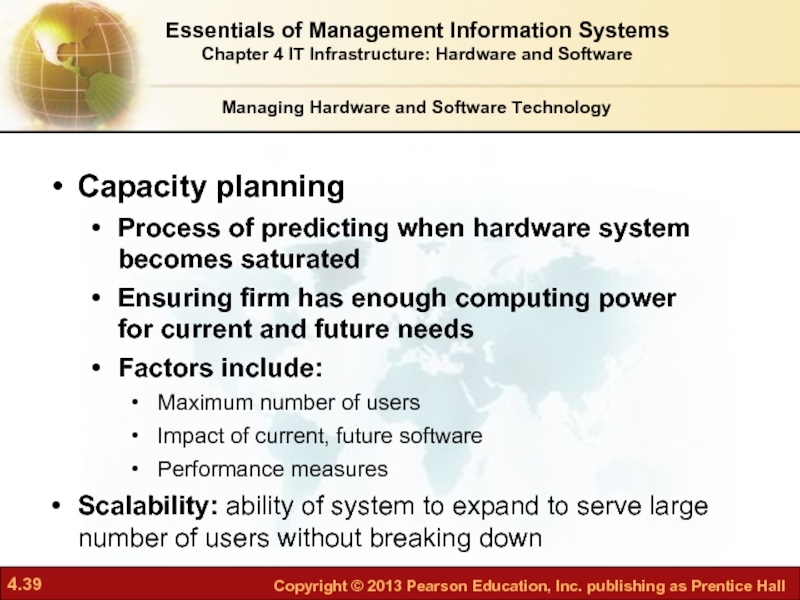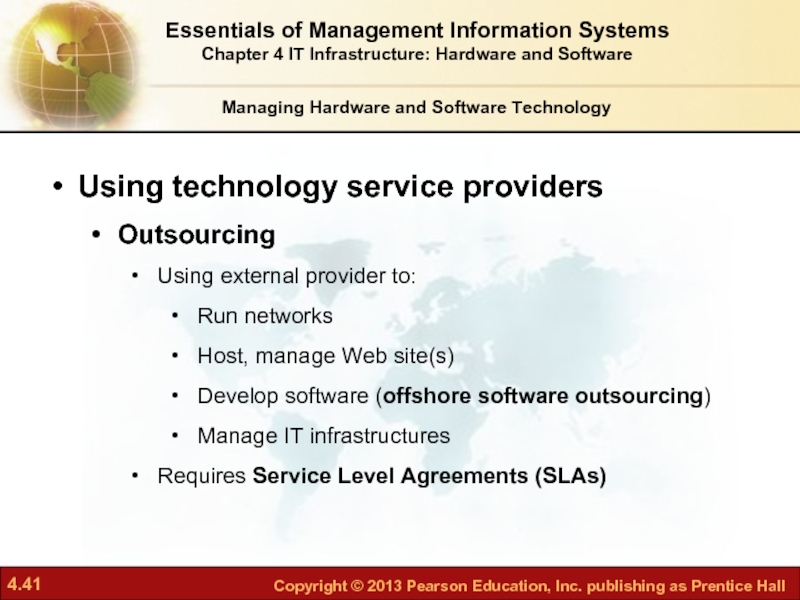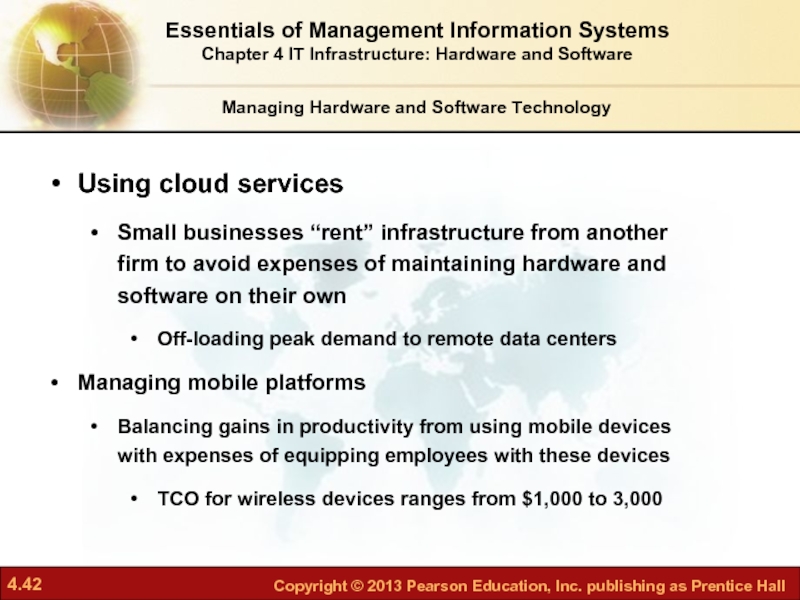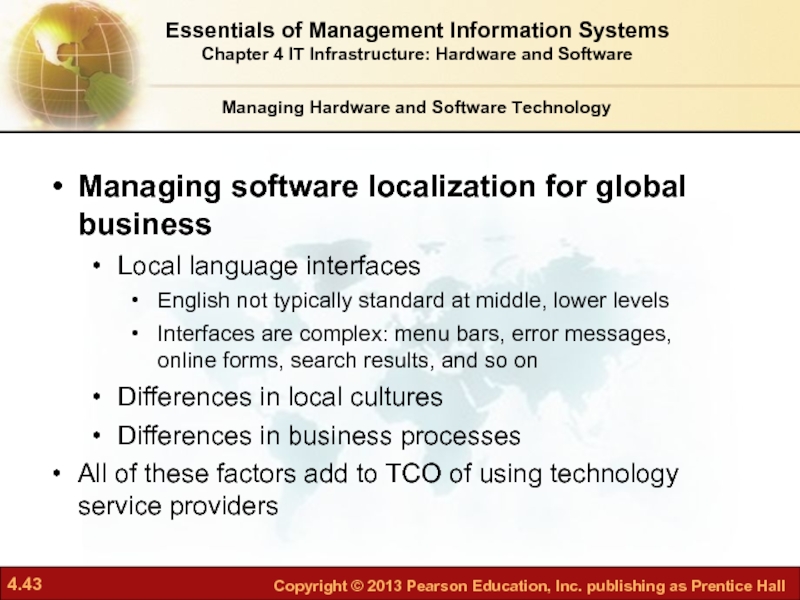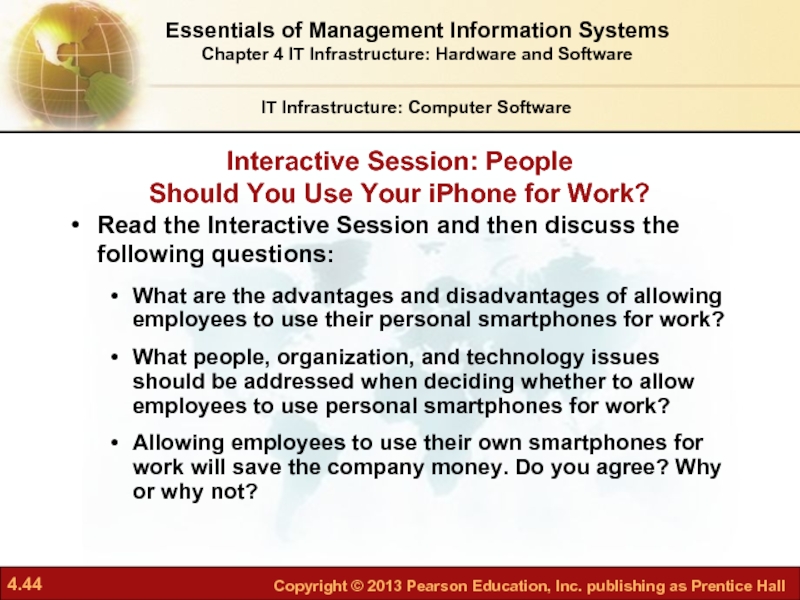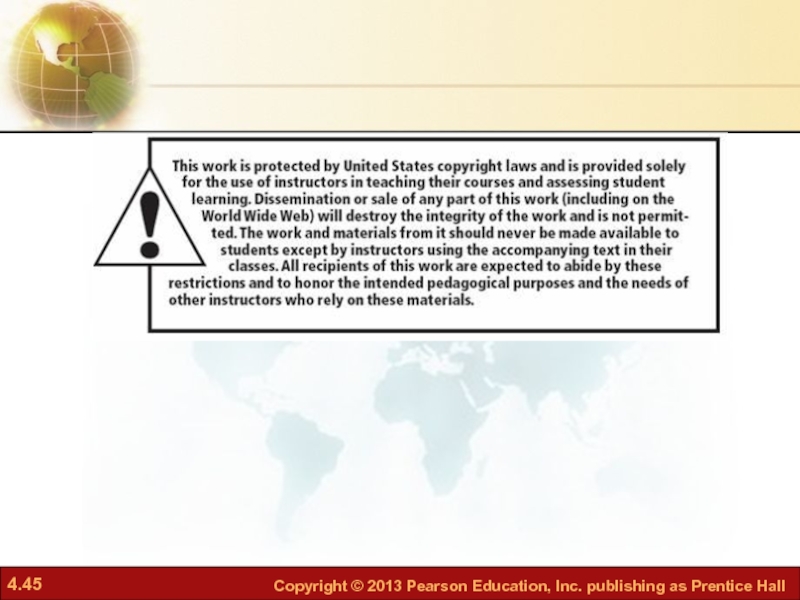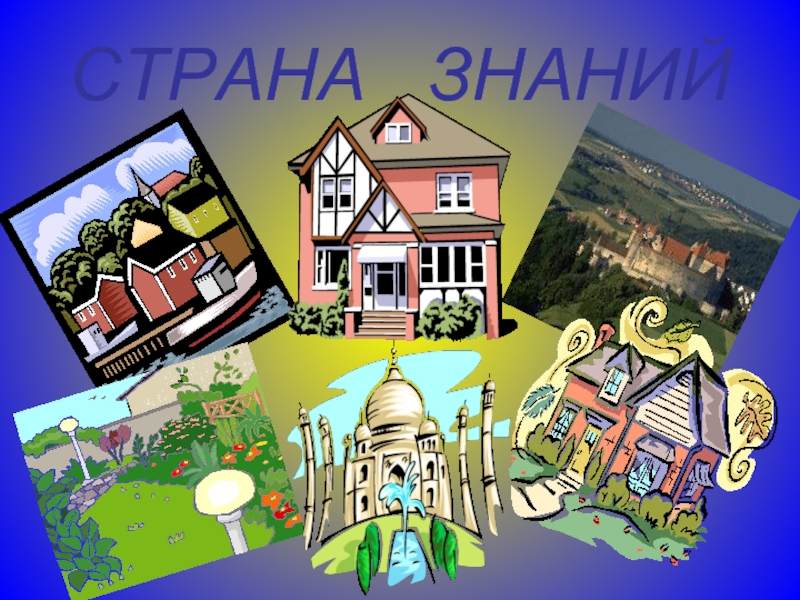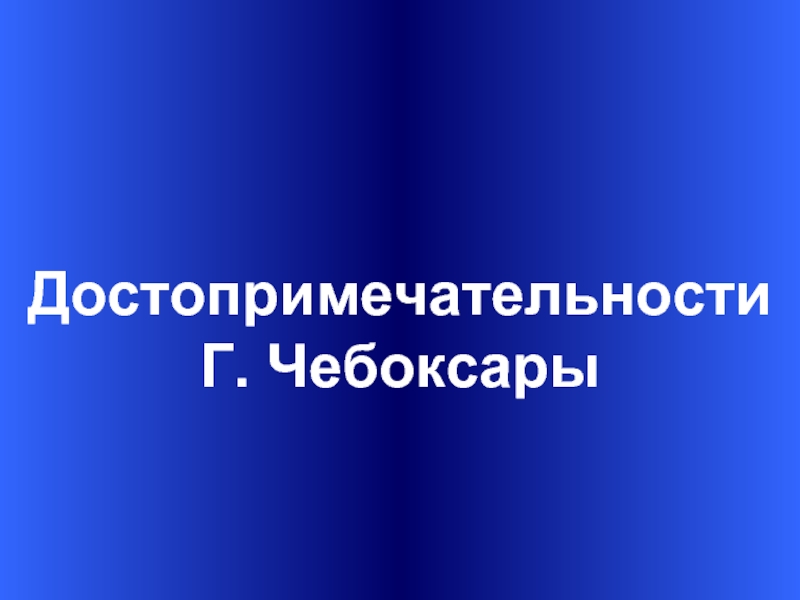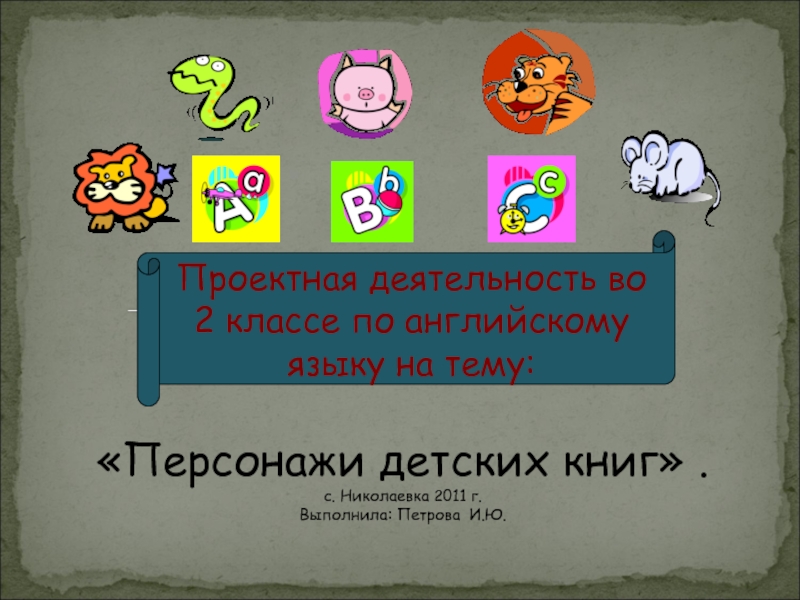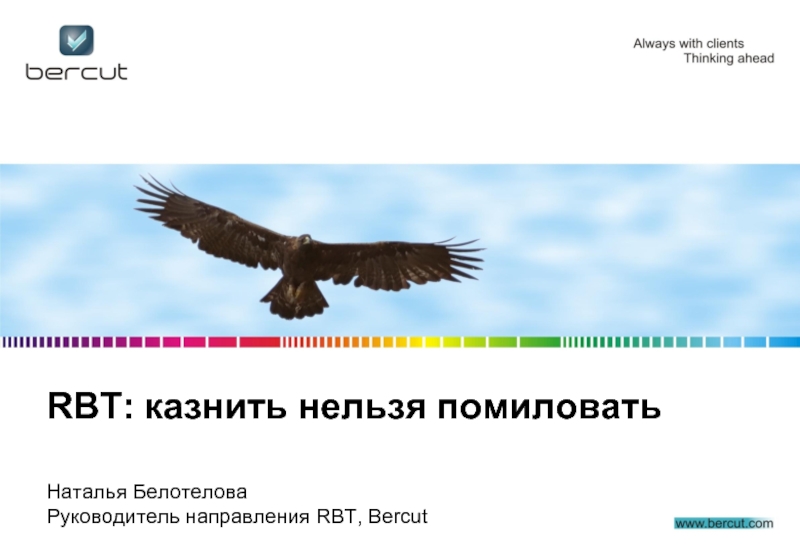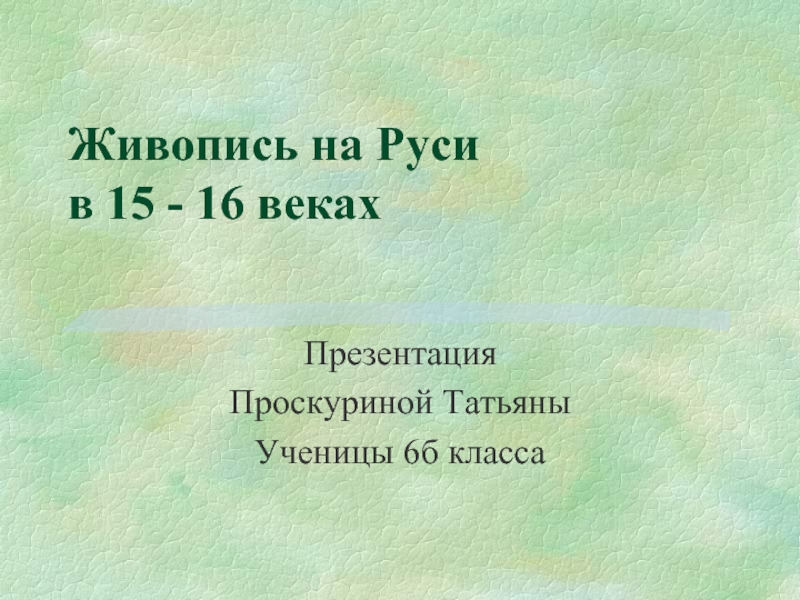- Главная
- Разное
- Дизайн
- Бизнес и предпринимательство
- Аналитика
- Образование
- Развлечения
- Красота и здоровье
- Финансы
- Государство
- Путешествия
- Спорт
- Недвижимость
- Армия
- Графика
- Культурология
- Еда и кулинария
- Лингвистика
- Английский язык
- Астрономия
- Алгебра
- Биология
- География
- Детские презентации
- Информатика
- История
- Литература
- Маркетинг
- Математика
- Медицина
- Менеджмент
- Музыка
- МХК
- Немецкий язык
- ОБЖ
- Обществознание
- Окружающий мир
- Педагогика
- Русский язык
- Технология
- Физика
- Философия
- Химия
- Шаблоны, картинки для презентаций
- Экология
- Экономика
- Юриспруденция
Chapter 4. IТ infrastructure. Hardware and software презентация
Содержание
- 1. Chapter 4. IТ infrastructure. Hardware and software
- 2. STUDENT LEARNING OBJECTIVES Essentials of Management Information
- 3. What are the most important contemporary hardware
- 4. BART Speeds Up with a New IT
- 5. Oracle’s PeopleSoft Enterprise applications replaced legacy applications.
- 6. Essentials of Management Information Systems Chapter 4
- 7. IT Infrastructure: Computer Hardware IT infrastructure: provides
- 8. IT Infrastructure Components IT Infrastructure: Computer Hardware
- 9. Computers come in different sizes with varying
- 10. Servers: Support computer network, sharing files, and
- 11. Supercomputer: More sophisticated computer used for tasks
- 12. Client/server computing: Form of distributed computing Splits
- 13. Client/server computing (cont.): Two-tiered client/server architecture Uses
- 14. Client/Server Computing IT Infrastructure: Computer Hardware Figure
- 15. A Multitiered Client/Server Network (N-Tier) IT Infrastructure:
- 16. Storage, Input, and Output Technology IT Infrastructure:
- 17. A Storage Area Network (SAN) IT Infrastructure:
- 18. Storage, Input, and Output Technology IT Infrastructure:
- 19. Storage, Input, and Output Technology IT Infrastructure:
- 20. Contemporary Hardware Trends IT Infrastructure: Computer
- 21. Examples of Nanotubes IT Infrastructure: Computer Hardware
- 22. Contemporary Hardware Trends IT Infrastructure: Computer
- 23. Contemporary Hardware Trends IT Infrastructure: Computer
- 24. Cloud Computing Platform IT Infrastructure: Computer Software
- 25. Contemporary Hardware Trends IT Infrastructure: Computer
- 26. Read the Interactive Session and then discuss
- 27. Contemporary Hardware Trends IT Infrastructure: Computer
- 28. Contemporary Hardware Trends IT Infrastructure: Computer
- 29. The Major Types of Software IT Infrastructure:
- 30. The software that controls computer activities GUIs
- 31. Application Software and Desktop Productivity Tools Application
- 32. Categories of Fourth-Generation Languages IT Infrastructure: Computer
- 33. Application Software and Desktop Productivity Tools Software
- 34. Spreadsheet Software IT Infrastructure: Computer Software Figure
- 35. Java: Operating system-independent, processor-independent, object-oriented programming language
- 36. Web services: Software components that exchange
- 37. How Dollar Rent-A-Car Uses Web Services IT
- 38. Open source software Linux, Apache Cloud-based
- 39. Managing Hardware and Software Technology Capacity planning
- 40. Managing Hardware and Software Technology Total Cost
- 41. Managing Hardware and Software Technology Using technology
- 42. Managing Hardware and Software Technology Using cloud
- 43. Managing Hardware and Software Technology Managing software
- 44. Interactive Session: People Should You Use Your
Слайд 14
Chapter
IT Infrastructure: Hardware and Software
Video Cases:
Case 1 Hudson's Bay
Case 2 Salesforce.com: SFA on the iPhone and iPod Touch
Instructional Videos:
Instructional Video 1 Google and IBM Produce Cloud Computing
Instructional Video 2 IBM Blue Cloud is Ready-to-Use Computing
Слайд 2STUDENT LEARNING OBJECTIVES
Essentials of Management Information Systems
Chapter 4 IT Infrastructure: Hardware
What are the components of IT infrastructure?
What are the major computer hardware, data storage, input, and output technologies used in business?
What are the major types of computer software used in business?
Слайд 3What are the most important contemporary hardware and software trends?
What are
STUDENT LEARNING OBJECTIVES
Essentials of Management Information Systems
Chapter 4 IT Infrastructure: Hardware and Software
Слайд 4BART Speeds Up with a New IT Infrastructure
Problem: Aging systems no
Solution: Replace and upgrade hardware and software and used leading-edge technology
Essentials of Management Information Systems
Chapter 4 IT Infrastructure: Hardware and Software
Слайд 5Oracle’s PeopleSoft Enterprise applications replaced legacy applications. Used blade servers, grid
Demonstrates IT’s role in using resources more efficiently, reducing computer energy usage, modernizing services.
Essentials of Management Information Systems
Chapter 4 IT Infrastructure: Hardware and Software
BART Speeds Up with a New IT Infrastructure
Слайд 6Essentials of Management Information Systems
Chapter 4 IT Infrastructure: Hardware and Software
BART
Слайд 7IT Infrastructure: Computer Hardware
IT infrastructure: provides platform for supporting all information
Computer hardware
Computer software
Data management technology
Organizes, manages, and processes business data concerned with inventory, customers, and vendors
Networking and telecommunications technology
Technology services
E.g., consultants for systems integration with legacy systems
Infrastructure Components
Essentials of Management Information Systems
Chapter 4 IT Infrastructure: Hardware and Software
Слайд 8IT Infrastructure Components
IT Infrastructure: Computer Hardware
Figure 4-1
A firm’s IT infrastructure is
Essentials of Management Information Systems
Chapter 4 IT Infrastructure: Hardware and Software
Слайд 9Computers come in different sizes with varying capabilities for processing information
Mobile
PCs
Workstations
More powerful mathematical and graphics-processing capabilities than a PC
Types of Computers
IT Infrastructure: Computer Hardware
Essentials of Management Information Systems
Chapter 4 IT Infrastructure: Hardware and Software
Слайд 10Servers:
Support computer network, sharing files, and resources
Provide hardware platform for e-commerce
Mainframes:
Large-capacity,
E.g., used by airlines to handle thousands of reservations per second
Types of Computers
IT Infrastructure: Computer Hardware
Essentials of Management Information Systems
Chapter 4 IT Infrastructure: Hardware and Software
Слайд 11Supercomputer:
More sophisticated computer used for tasks requiring extremely rapid and complex
Used in engineering, scientific simulations, military/weapons research, weather forecasting
Grid computing:
Power of geographically remote computers connected into single network to act as “virtual supercomputer”
Types of Computers
IT Infrastructure: Computer Hardware
Essentials of Management Information Systems
Chapter 4 IT Infrastructure: Hardware and Software
Слайд 12Client/server computing:
Form of distributed computing
Splits processing between “clients” and “servers”
Clients: user
Servers: store and process shared data and perform network management activities
Types of Computers
IT Infrastructure: Computer Hardware
Essentials of Management Information Systems
Chapter 4 IT Infrastructure: Hardware and Software
Слайд 13Client/server computing (cont.):
Two-tiered client/server architecture
Uses two types of machines
Multi-tiered client/server architecture
Balances load of network over several levels of servers
E.g., Web servers and application servers
Types of Computers
IT Infrastructure: Computer Hardware
Essentials of Management Information Systems
Chapter 4 IT Infrastructure: Hardware and Software
Слайд 14Client/Server Computing
IT Infrastructure: Computer Hardware
Figure 4-2
In client/server computing, computer processing is
Essentials of Management Information Systems
Chapter 4 IT Infrastructure: Hardware and Software
Слайд 15A Multitiered Client/Server Network (N-Tier)
IT Infrastructure: Computer Hardware
Figure 4-3
Essentials of Management
Chapter 4 IT Infrastructure: Hardware and Software
In a multitiered client/server network, client requests for service are handled by different levels of servers.
Слайд 16Storage, Input, and Output Technology
IT Infrastructure: Computer Hardware
Primary secondary storage technologies
Magnetic
Hard drives, USB flash drives
RAID: can package hundreds of drives for massive storage requirements
Optical disks
CD-ROM, CD-RW, DVD, DVD-RW
Magnetic tape
Storage networking: SANs
Connect multiple storage devices on a separate high-speed network dedicated to storage
Essentials of Management Information Systems
Chapter 4 IT Infrastructure: Hardware and Software
Слайд 17A Storage Area Network (SAN)
IT Infrastructure: Computer Hardware
Figure 4-4
A typical SAN
Essentials of Management Information Systems
Chapter 4 IT Infrastructure: Hardware and Software
Слайд 18Storage, Input, and Output Technology
IT Infrastructure: Computer Hardware
Input devices:
Gather data and
Keyboard
Computer mouse
Touch screen
Optical character recognition
Magnetic ink character recognition
Pen-based input
Digital scanner
Audio input
Sensors
Essentials of Management Information Systems
Chapter 4 IT Infrastructure: Hardware and Software
Слайд 19Storage, Input, and Output Technology
IT Infrastructure: Computer Hardware
Output devices:
Display data after
Monitor
Flat-panel, CRT
Printer
Impact, nonimpact
Audio output
Essentials of Management Information Systems
Chapter 4 IT Infrastructure: Hardware and Software
Слайд 20
Contemporary Hardware Trends
IT Infrastructure: Computer Hardware
The emerging mobile digital platform
Cell phones,
Netbooks and tablet computers
E-book readers
Nanotechnology
Creating computer chips and other devices thousands of times smaller through manipulating individual atoms, molecules
Essentials of Management Information Systems
Chapter 4 IT Infrastructure: Hardware and Software
Слайд 21Examples of Nanotubes
IT Infrastructure: Computer Hardware
Figure 4-5
Nanotubes are tiny tubes about
Essentials of Management Information Systems
Chapter 4 IT Infrastructure: Hardware and Software
Слайд 22
Contemporary Hardware Trends
IT Infrastructure: Computer Hardware
Virtualization:
Process of presenting a set
Server virtualization: running more than one operating system at the same time on single machine
Essentials of Management Information Systems
Chapter 4 IT Infrastructure: Hardware and Software
Слайд 23
Contemporary Hardware Trends
IT Infrastructure: Computer Hardware
Cloud Computing:
A model of computing in
Cloud infrastructure as a service
Cloud platform as a service
Cloud software as a service
Public vs. private clouds
Utility computing, on-demand computing
Data storage security is in hands of provider
Essentials of Management Information Systems
Chapter 4 IT Infrastructure: Hardware and Software
Слайд 24Cloud Computing Platform
IT Infrastructure: Computer Software
Figure 4-6
In cloud computing, hardware and
Essentials of Management Information Systems
Chapter 4 IT Infrastructure: Hardware and Software
Слайд 25
Contemporary Hardware Trends
IT Infrastructure: Computer Hardware
Green computing
Practices and technologies for
Key priority is power reduction
IT in U.S. provides 2% of U.S. power demand and 2% of world’s greenhouse gases
Essentials of Management Information Systems
Chapter 4 IT Infrastructure: Hardware and Software
Слайд 26Read the Interactive Session and then discuss the following questions:
What business
What solutions are available for these problems? Which are the most environment-friendly?
What are the business benefits and costs of these solutions?
Should all firms move toward green computing? Why or why not?
Interactive Session: Organizations
Green Data Centers: Good for Business?
IT Infrastructure: Computer Hardware
Essentials of Management Information Systems
Chapter 4 IT Infrastructure: Hardware and Software
Слайд 27
Contemporary Hardware Trends
IT Infrastructure: Computer Hardware
High-performance and power-saving processors
Multicore processor:
Integrated circuit
Enhanced performance and reduced power consumption
Power-efficient processors
Low power consumption essential in mobile computing
Essentials of Management Information Systems
Chapter 4 IT Infrastructure: Hardware and Software
Слайд 28
Contemporary Hardware Trends
IT Infrastructure: Computer Hardware
Autonomic computing:
Development of systems that can
Essentials of Management Information Systems
Chapter 4 IT Infrastructure: Hardware and Software
Слайд 29The Major Types of Software
IT Infrastructure: Computer Software
Figure 4-7
The relationship among
Essentials of Management Information Systems
Chapter 4 IT Infrastructure: Hardware and Software
Слайд 30The software that controls computer activities
GUIs and multitouch
PC operating systems
Windows (Windows
Mac (OSX Lion)
UNIX
Linux (open source)
Mobile operating systems
Chrome, Android, iOS
Operating System Software
IT Infrastructure: Computer Software
Essentials of Management Information Systems
Chapter 4 IT Infrastructure: Hardware and Software
Слайд 31Application Software and Desktop Productivity Tools
Application programming languages for business
COBOL
C, C++
Visual
Fourth-generation languages
Software tools that enable end-users to develop software applications
Tend to be nonprocedural, may use natural languages
IT Infrastructure: Computer Software
Essentials of Management Information Systems
Chapter 4 IT Infrastructure: Hardware and Software
Слайд 32Categories of Fourth-Generation Languages
IT Infrastructure: Computer Software
Essentials of Management Information Systems
Chapter
Слайд 33Application Software and Desktop Productivity Tools
Software packages and desktop productivity tools
Word
Spreadsheet software
Data management software
Presentation graphics
Software suites
Web browsers
IT Infrastructure: Computer Software
Essentials of Management Information Systems
Chapter 4 IT Infrastructure: Hardware and Software
Слайд 34Spreadsheet Software
IT Infrastructure: Computer Software
Figure 4-8
Spreadsheet software organizes data into columns
Essentials of Management Information Systems
Chapter 4 IT Infrastructure: Hardware and Software
Слайд 35Java:
Operating system-independent, processor-independent, object-oriented programming language
Hypertext markup language (HTML):
Page description language
HTML5
Next evolution of HTML
Enables multimedia embedding without 3rd party add-ons like Flash
Software for the Web: Java and HTML
IT Infrastructure: Computer Software
Essentials of Management Information Systems
Chapter 4 IT Infrastructure: Hardware and Software
Слайд 36Web services:
Software components that exchange information with one another using
XML (eXtensible Markup Language)
Foundation of Web services
Service oriented architecture (SOA)
Collection of services used to build an organization’s software systems
Web Services
IT Infrastructure: Computer Software
Essentials of Management Information Systems
Chapter 4 IT Infrastructure: Hardware and Software
Слайд 37How Dollar Rent-A-Car Uses Web Services
IT Infrastructure: Computer Software
Figure 4-9
Dollar Rent-A-Car
Essentials of Management Information Systems
Chapter 4 IT Infrastructure: Hardware and Software
Слайд 38
Open source software
Linux, Apache
Cloud-based software and tools
SaaS (software as a service)
Google
Mashups
Zip Realty uses Google Maps and Zillow.com
Apps
Mobile apps
Software Trends
IT Infrastructure: Computer Software
Essentials of Management Information Systems
Chapter 4 IT Infrastructure: Hardware and Software
Слайд 39Managing Hardware and Software Technology
Capacity planning
Process of predicting when hardware system
Ensuring firm has enough computing power for current and future needs
Factors include:
Maximum number of users
Impact of current, future software
Performance measures
Scalability: ability of system to expand to serve large number of users without breaking down
Essentials of Management Information Systems
Chapter 4 IT Infrastructure: Hardware and Software
Слайд 40Managing Hardware and Software Technology
Total Cost of Ownership (TCO) model
Used to
Direct costs: hardware, software purchase costs
Indirect costs: ongoing administration costs, upgrades, maintenance, technical support, training, utility, and real estate costs
Hidden costs: support staff, downtime, additional network management
TCO can be reduced through increased centralization, standardization of hardware, and software resources
Essentials of Management Information Systems
Chapter 4 IT Infrastructure: Hardware and Software
Слайд 41Managing Hardware and Software Technology
Using technology service providers
Outsourcing
Using external provider to:
Run
Host, manage Web site(s)
Develop software (offshore software outsourcing)
Manage IT infrastructures
Requires Service Level Agreements (SLAs)
Essentials of Management Information Systems
Chapter 4 IT Infrastructure: Hardware and Software
Слайд 42Managing Hardware and Software Technology
Using cloud services
Small businesses “rent” infrastructure from
Off-loading peak demand to remote data centers
Managing mobile platforms
Balancing gains in productivity from using mobile devices with expenses of equipping employees with these devices
TCO for wireless devices ranges from $1,000 to 3,000
Essentials of Management Information Systems
Chapter 4 IT Infrastructure: Hardware and Software
Слайд 43Managing Hardware and Software Technology
Managing software localization for global business
Local language
English not typically standard at middle, lower levels
Interfaces are complex: menu bars, error messages, online forms, search results, and so on
Differences in local cultures
Differences in business processes
All of these factors add to TCO of using technology service providers
Essentials of Management Information Systems
Chapter 4 IT Infrastructure: Hardware and Software
Слайд 44Interactive Session: People
Should You Use Your iPhone for Work?
IT Infrastructure: Computer
Read the Interactive Session and then discuss the following questions:
What are the advantages and disadvantages of allowing employees to use their personal smartphones for work?
What people, organization, and technology issues should be addressed when deciding whether to allow employees to use personal smartphones for work?
Allowing employees to use their own smartphones for work will save the company money. Do you agree? Why or why not?
Essentials of Management Information Systems
Chapter 4 IT Infrastructure: Hardware and Software
